Horse News
Member
De-Mystifying the Differences Between Mules, Donkeys, and Horses
Many people believe mules are stubborn, and yet they excel in many disciplines traditionally dominated by horses. A mule called Ticket has completed the 100-mile Western States Trail Ride (Tevis Cup) three times, while Wallace the Great became the first mule to win a British Dressage competition back in 2018.
Mules are strong, surefooted animals that require less nutrition than horses and rarely require shoes. They are less susceptible to lameness and capable of carrying heavier loads, yet many people dismiss them as stubborn and lazy.
Despite their ability to perform and compete with horses, mules remain comparatively unpopular. There are approximately 60 million horses worldwide, but only 10 million mules, even though mules have many advantages over horses.
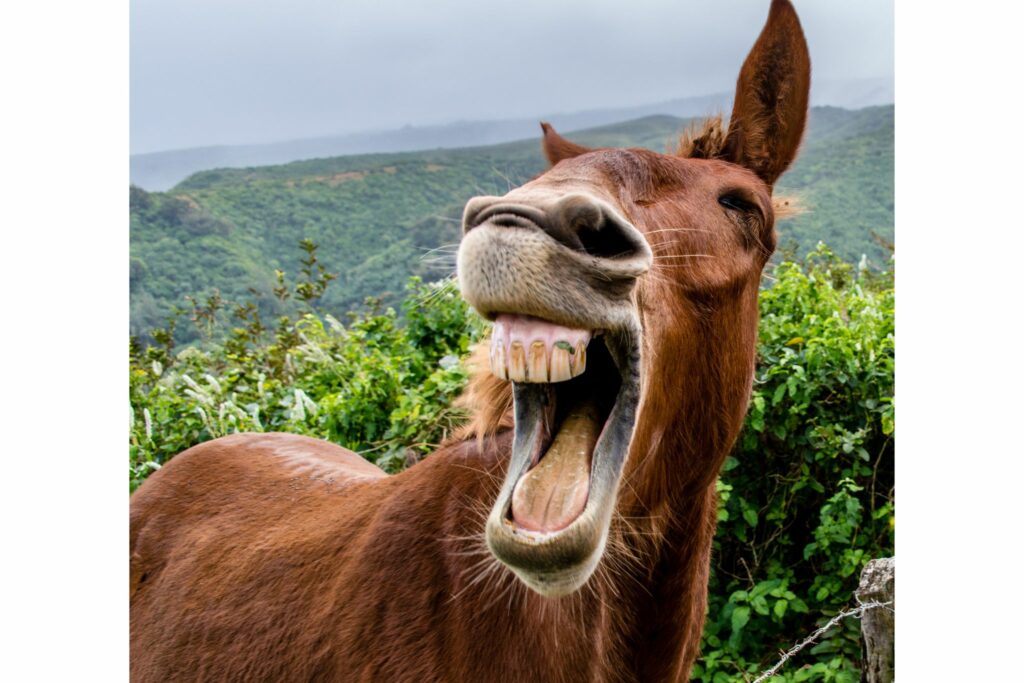
Source: Canva
Mules: Defined
A mule is the resulting offspring of a male donkey and a female horse. It’s a hybrid equine distinct from the hinny, which is the result of a male horse breeding with a female donkey.
Mules are generally larger than hinnies, although both possess an odd number of chromosomes, which causes them to be 99.9% sterile and largely incapable of reproduction.
The Origin of Mules
The exact origins of the mule are unclear, with some sources claiming they originated in Asia and others arguing that the “inhabitants of Paphlagonia and Nicaea” (modern-day Turkey) were the first to breed mules.
Evidence suggests that mules quickly overtook camels as the preferred pack animal in ancient Egypt and were used to transport turquoise from the Sinai mines as early as 2100 BC.
Mules were also highly regarded in ancient Greece, where their hard hooves and surefootedness made them more agile over the rocky terrain than horses.
Mules have played critical roles in many historical events, including both the First and Second World Wars, where they gained a reputation for being hard-working and intelligent animals with “an unerring instinct for self-preservation.”
Mule Statistics
There are approximately 10 million mules worldwide, most of whom are working animals.
According to a 2021 study of global donkey and mule populations, the largest population of mules is in Mexico, where they’re used for agriculture, mining, construction, transport, and tourism.
Although there was a 53% decrease in the global mule population between 1997 and 2018, researchers noted an increase in the number of mules living in France. The reasons for this are unclear, although mules continue to be used for agricultural work and as pack and riding animals.
Mule Purposes
Traditionally, mules have been used as working animals, performing a range of tasks, from pulling carts to carrying heavy loads. They were used extensively for pulling coal cars in mines, and in agriculture where they were used for both plowing and transportation.
People also have been riding mules since medieval times, appreciating their surefootedness, stamina, and strength.
Although mules were traditionally used for long-distance travel, today they compete alongside horses in various disciplines, including endurance and dressage.
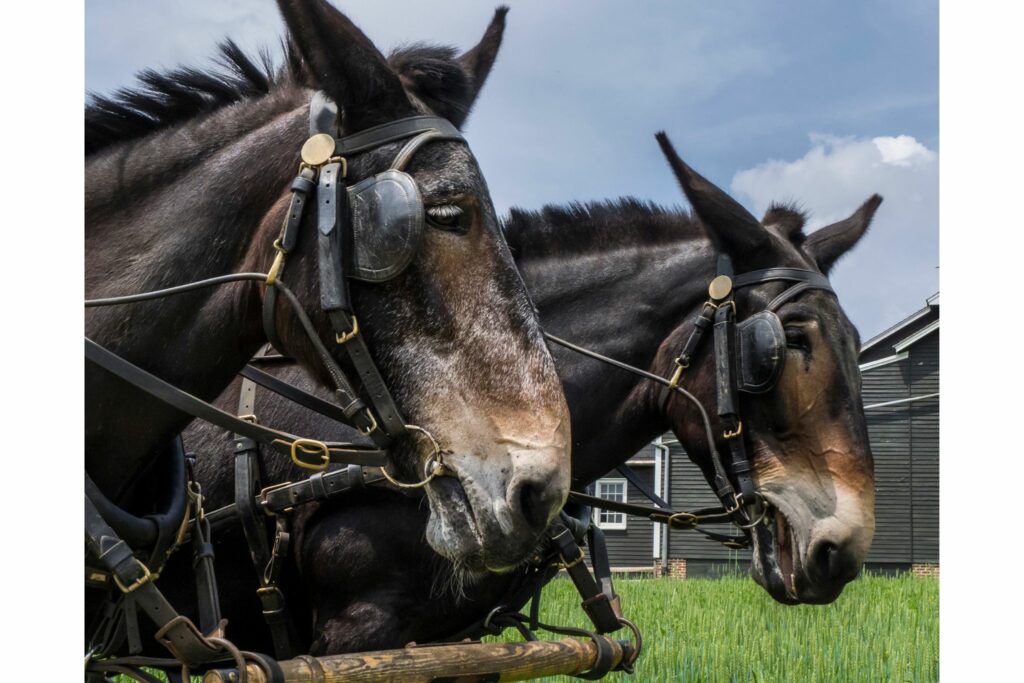
Source: Canva
Mules Compared to Donkeys and Horses
Mules are larger than donkeys, which makes them more suitable for an adult to ride, and hardier than horses, which makes them easier to keep. On the downside, they are prone to obesity, like donkeys, and susceptible to many of the same diseases as horses.
Mule vs. Horses
When galloping, horses travel at around 30mph, making them considerably faster than mules, who rarely exceed 15 mph. When it comes to traveling long distances, however, the mule will outperform many breeds of horses thanks to its strong hooves and agility.
Mules are stronger than horses and can carry proportionally heavier loads. While horses can only carry around 20% of their body weight, mules can carry closer to 30% and can pull the equivalent of their own weight for between 20 to 25 miles per day.
Although stronger than horses, mules aren’t quite as athletic, and would struggle to hold their own in a showjumping competition. Currently, the highest obstacle cleared by a mule stood 72 inches (6 feet) high, which is over two feet lower than the record set by a horse.
What mules lack in athleticism, they make up for in strength. Lameness is a common problem in horses, but virtually unheard of in mules, who have stronger legs—along with a natural propensity for self-preservation.
Mules also are cheaper and easier to keep than horses. They eat less and do better on poor-quality forage than horses.
On the downside, they are more susceptible to obesity and less tolerant of a diet that’s high in protein and energy.
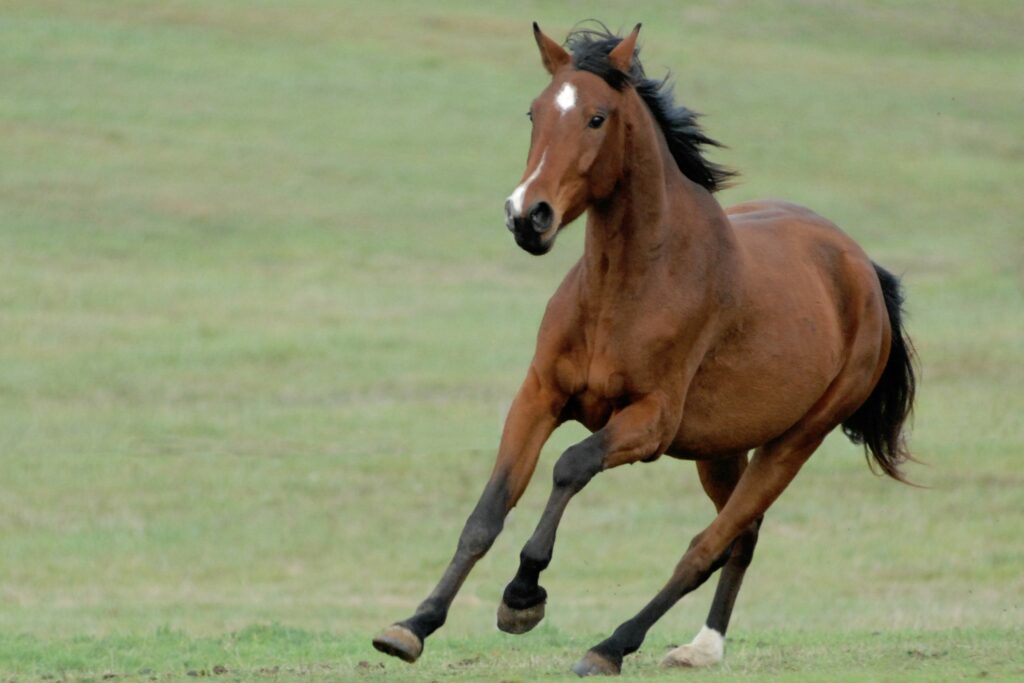
A horse. Source: Canva
Mule vs. Donkeys
Most people feel that donkeys are too small for adults to ride, although there are many places in the world where this is a common occurrence.
Mules are generally considered stronger and faster than donkeys, although some particularly speedy donkeys could give a mule a run for its money.
Donkeys and mules are both intelligent animals and are widely believed to outsmart the horse. Like donkeys, mules have a natural sense of self-preservation, which has led to both equids being perceived as more stubborn than a horse.
Mule Terminology
Most of you already know that a female horse is a mare, and a male horse is either a stallion or a gelding, depending on whether or not it’s castrated. How does that terminology change with a mule?
Female Mule: Mare mule or Molly
Intact Male Mule: John or Jack
Donkeys also use different terms:
Female Donkey: Jenny
Intact Male Donkey: Jack
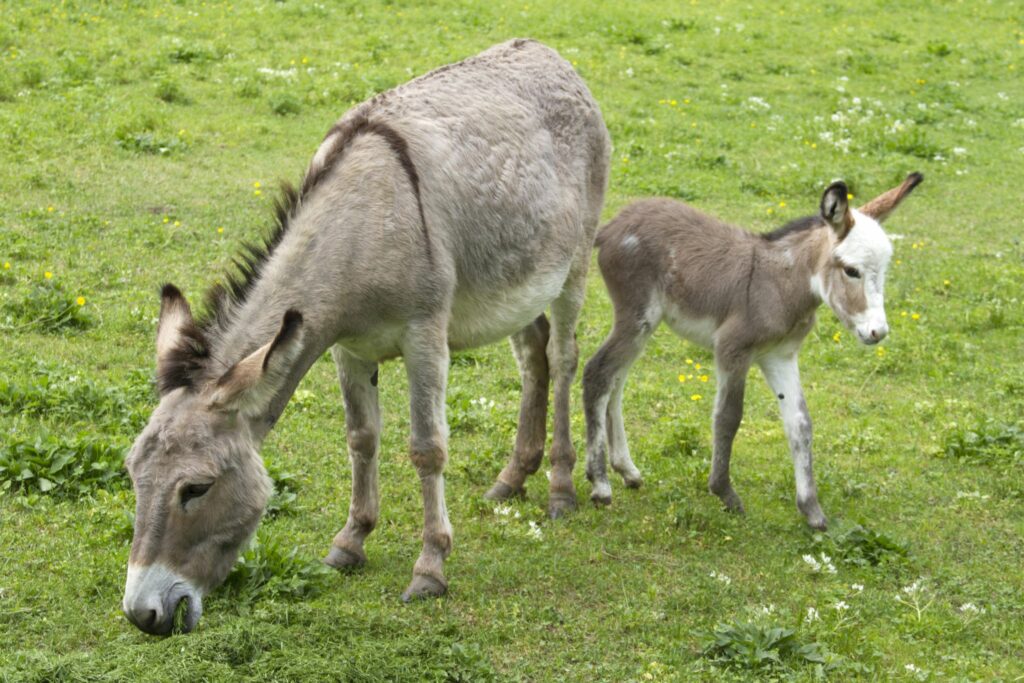
A female donkey (jenny) and donkey foal. Source: Canva
Horses, mules, and donkeys that have been gelded are all referred to as geldings.
Breeding for a Mule
If you want to breed a mule, you’ll need a donkey stallion and a female horse or mare. Ideally, you should select a mare that’s at least three years old, has good conformation, and an excellent work ethic.
The conformation of the jack is slightly less important, although his attitude is critical. An overly boisterous jack will likely intimidate a mare, making her unwilling to mate, so you’ll stand a better chance with a gentlemanly jack! (Or artificial insemination.)
Feeding a Mule
Like donkeys, mules have lower nutritional needs than horses. While horses consume approximately 3% of their body weight in forage per day, donkeys only eat around 1.5% of theirs, suggesting that a mule’s requirements fall somewhere in between.
Mules and donkeys are generally easy-keepers that thrive on lower-quality pasture grasses.
Horses struggle to extract the energy and protein they need from such fibrous forage and therefore need more supplementary feeding than either donkeys or mules.
Benefits of Mules
Mules are strong, intelligent, and cheaper to keep than horses. Although similar to donkeys, they’re bigger and tougher which means they’re more suitable for adult riders. Mules are surefooted and have, as mentioned, a natural propensity for self-preservation.
Events Mules Excel In
Mules are surprisingly versatile and excel in a range of disciplines, from driving to dressage. Mules compete against horses in competitive endurance riding, dressage, Western dressage, and combined driving.
What You Can Do With A Mule
Anything you can do with a horse, you can do with a well-trained mule. Although mules can’t compete against horses in eventing or hunter/jumper competitions, some mule owners are petitioning for this to change.
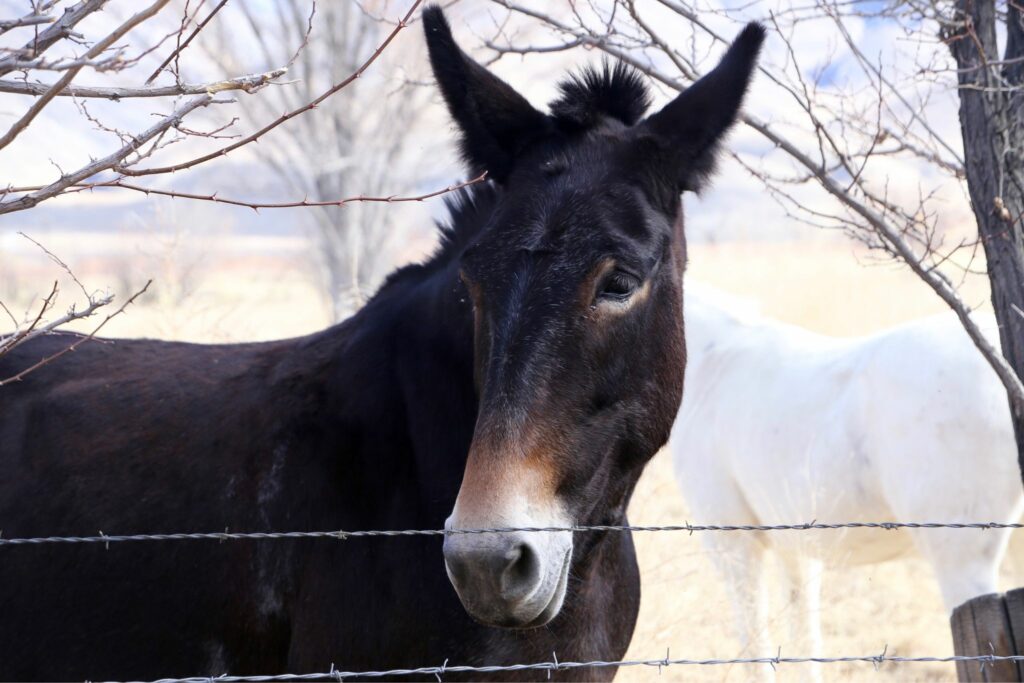
Source: Canva
Disadvantages of Mules
Training a mule is widely considered more challenging than training a horse. Mules are unwilling to perform any task that may jeopardize them, so need more convincing when trying something new.
They don’t respond the same way to the pressure and release technique commonly used with horses, and need a solid foundation of trust before they’re willing to perform.
Mules are also prone to obesity and more sensitive to a high-energy diet than horses.
Although mules can’t jump as high as horses, they can be harder to keep in an enclosure and quickly learn to exploit low or rickety fences.
What You Can’t Do With A Mule
The most obvious thing you can’t do with a mule is breed. Mules are largely sterile and incapable of reproduction, although some mare mules have produced offspring, either naturally or as a result of embryo transfer.
Mules are also banned from certain equestrian disciplines, like hunter/jumper classes and eventing.
Frequently Asked Questions
Q: Are mules more prone to certain injuries or illnesses?
Mules are far less prone to lameness than horses but equally susceptible to many common diseases, especially those associated with obesity. Mules can contract common diseases like West Nile virus and Potomac horse fever just as easily as horses, and are similarly prone to laminitis and metabolic syndrome.
Q: Why can’t mules have baby mules?
While donkeys have 62 chromosomes and horses 64, the mule has just 63. An odd number of chromosomes leads to infertility because they can’t pair up correctly, which means they cannot produce functional reproductive cells.
Q: Can a mule reproduce?
Most mules are infertile, making them incapable of reproduction. A handful of mare mules have successfully reproduced, although their offspring have often “exhibited no characteristics of any donkey.”
Q: Is a mule stronger than a horse?
Mules are stronger than horses and capable of carrying up to 30% of their body weight, compared to horses, who can only carry 20%. Mules can also pull heavier loads for longer periods than most horse breeds.
Q: Are mules and donkeys the same?
Mules share some of the donkey’s characteristics but are equine hybrids, whereas donkeys are a recognized species. Mules tend to be bigger than donkeys, with smaller ears and the long, flowing tail of their horse parent.
Q: Can a mule reproduce with a horse?
Generally speaking, no. Very few mules can actually reproduce, regardless of whether they’re bred to a horse or a donkey. The few fertile mules that have reproduced have had foals with more horse characteristics than donkey ones.
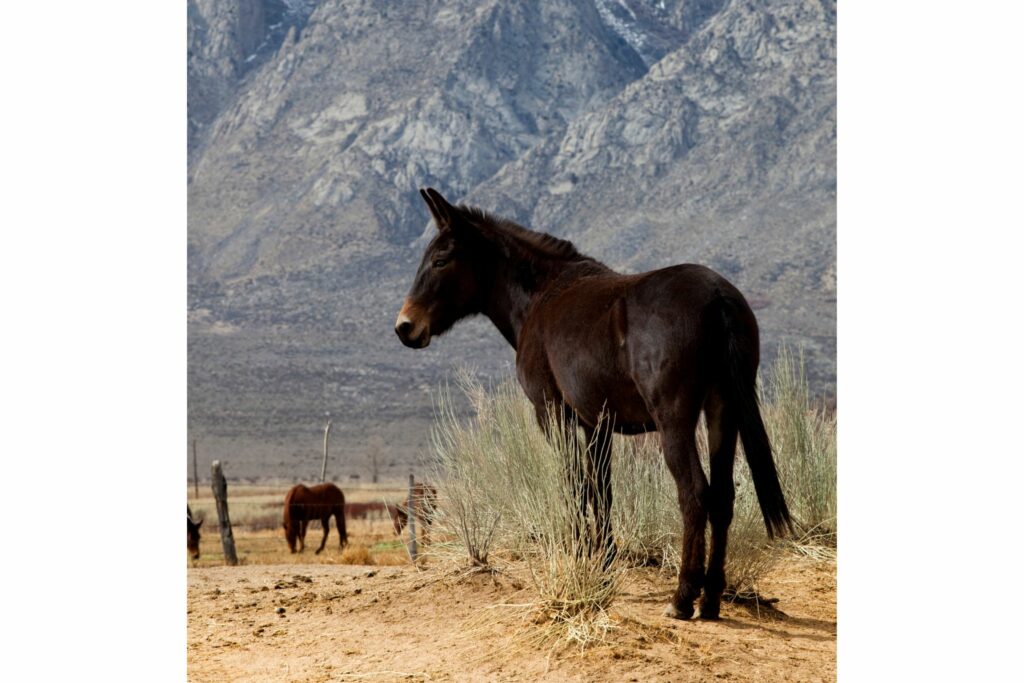
Source: Canva
Parting Thoughts
Mules are becoming more popular and more widely accepted within the horse community. Their surefootedness and natural intelligence make them great for trail riding, while their strength and power mean they excel as draft animals.
Not only are mules surprisingly versatile, proving their abilities in both the dressage arena and the endurance riding scene, but they also have lower nutritional requirements than horses, making them easier and cheaper to keep.
P.S. Enjoy this article? Trot on over to:
- Donkeys and Horses: Better Together or Bad Roommates?
- How to Adopt a Wild Donkey: A Helpful Beginner’s Guide
- 5 Simple Steps to Halter Training Your Wild Donkey
- Safety First: How Much Can a Donkey Carry?
- 13 Best Treats and Toys for Busy-Minded Donkeys
- Why horses are dangerous (but worth the risk!)
- 3 Fear-Free Secrets to Gain Your Horse’s Trust & Respect
- Bonding 101: How to Make the Most of Your Horse Time
Sources:
https://www.mulemuseum.org/history-of-the-mule.html
https://www.worldwar1centennial.org/index.php/the-animals/3231-test-article-for-mules.html
https://riverearth.com/how-much-can-your-horse-or-mule-pull/#.ZGH08i1BxQI
https://en.wikipedia.org/wiki/Mule
The post The Mighty Mule: Strong, Surefooted and SO Clever appeared first on Horse Rookie.
Continue reading...
